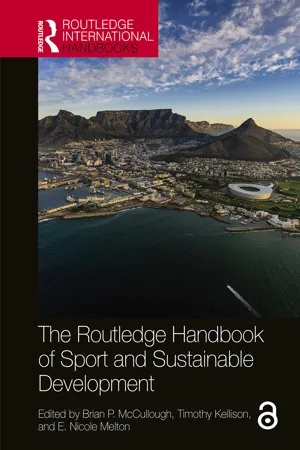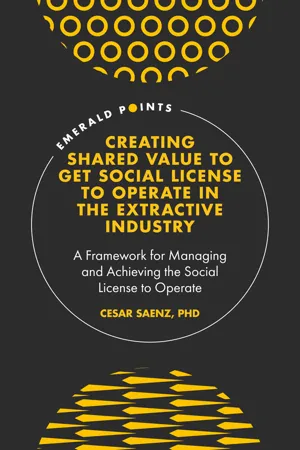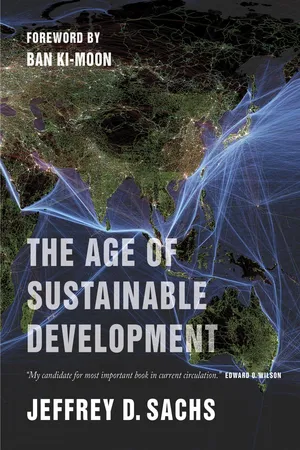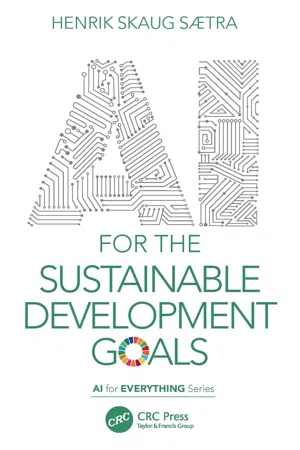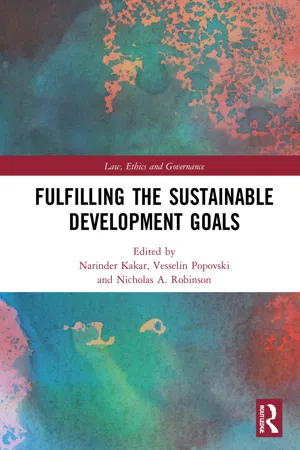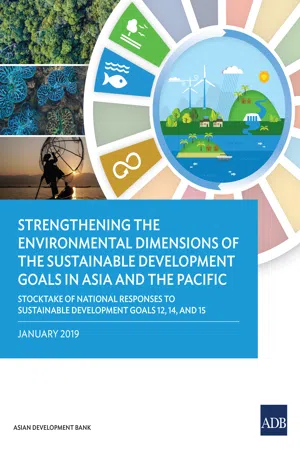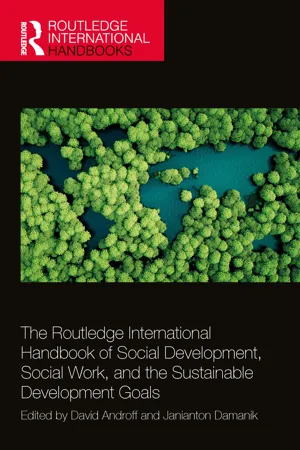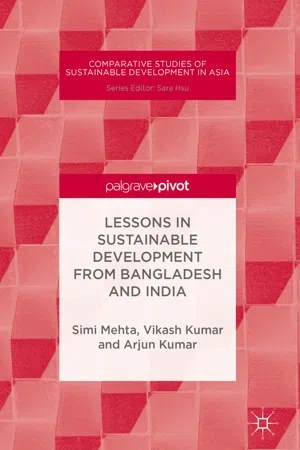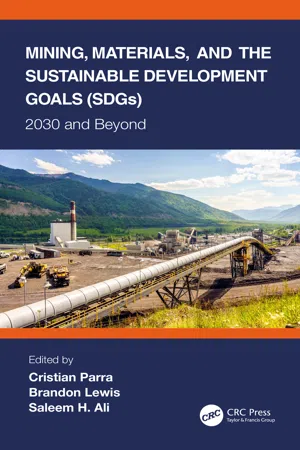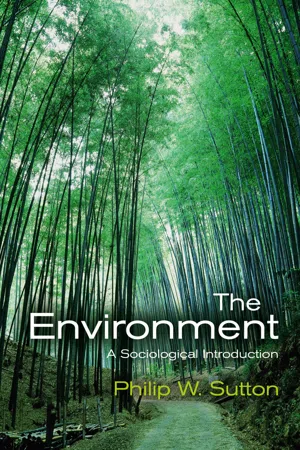Geography
Sustainable Development Goal 8
Sustainable Development Goal 8 aims to promote sustained, inclusive, and sustainable economic growth, full and productive employment, and decent work for all. It also targets to achieve higher levels of economic productivity through diversification, technological upgrading, and innovation. Additionally, it seeks to improve resource efficiency in consumption and production and promote sustainable tourism.
Written by Perlego with AI-assistance
Related key terms
Related key terms
1 of 4
Related key terms
1 of 3
11 Key excerpts on "Sustainable Development Goal 8"
- Brian P. McCullough, Timothy Kellison, E. Nicole Melton, Brian P. McCullough, Timothy Kellison, E. Nicole Melton(Authors)
- 2022(Publication Date)
- Routledge(Publisher)
Kathryn L. Heinze and Sara SoderstromDOI: 10.4324/9781003023968-23Sustainable Development Goal 8 is to “promote sustained, inclusive and sustainable economic growth, full and productive employment and decent work for all” (General Assembly, 2015 , p. 14). There are 10 main targets associated with SDG 8, and two additional targets (a) and (b). These targets are outlined in Table 23.1.Table 23.1Targets of Sustainable Development Goal 88.1 Increase economic productivity through “high-value added and labor-intensive sectors” 8.2 Achieve higher levels of economic productivity through diversification, technological upgrading and innovation, including through a focus on high-value added and undefined labour-intensive sectors 8.3 Promote development-oriented policies that support productive activities, decent job creation, entrepreneurship, creativity and innovation, and encourage the formalization and growth of micro-, small- and medium-sized enterprises, including through access to financial services8.4 Improve progressively, through 2030, global resource efficiency in consumption and production and endeavour to decouple economic growth from environmental degradation, in accordance with the 10-Year Framework of Programmes on Sustainable Consumption and Production, with developed countries taking the lead8.5 By 2030, achieve full and productive employment and decent work for all women and men, including for young people and persons with disabilities, and equal pay for work of equal value 8.6 By 2020, substantially reduce the proportion of youth not in employment, education or training 8.7 Take immediate and effective measures to eradicate forced labor, end modern slavery and human trafficking and secure the prohibition and elimination of the worst forms of child labor, including recruitment and use of child soldiers, and by 2025 end child labor in all its forms- eBook - ePub
Creating Shared Value to get Social License to Operate in the Extractive Industry
A Framework for Managing and Achieving the Social License to Operate
- Cesar Saenz(Author)
- 2021(Publication Date)
- Emerald Publishing Limited(Publisher)
(12)Ensure sustainable consumption and production patterns; (13)Take urgent action to combat climate change and its impacts; (14)Conserve and sustainably use the oceans, seas, and marine resources for sustainable development; (15)Protect, restore, and promote sustainable use of terrestrial ecosystems, sustainably manage forests, combat desertification, and halt and reverse land degradation and halt biodiversity loss; (16)Promote peaceful and inclusive societies for sustainable development, provide access to justice for all and build effective, accountable, and inclusive institutions at all levels; (17)Strengthen the means of implementation and revitalize the global partnership for sustainable development.The SDGs are the contemporary incarnation of the international community's developmental and humanitarian agenda (Poku & Whitman, 2011 ; Sachs, 2005 ; Yiu & Saner, 2014 ).The Atlas Map was created by the Columbia Center on Sustainable Investments to understand the link between mining projects and the SDGs. What this Atlas Map tries to dissect is the opportunities and setbacks that a mining sector can incur into by trying to accomplish the SDGs. Mining can impact positively and negatively on the SDGs, while some goals are easier to follow through for the mining sector, like Goals 1 (Poverty) and 2 (Hunger), and some Goals like 15 (Protect, restore, and promote use of terrestrial ecosystems) and 13 (Climate change) tend to be affected negatively, and the strategies used for them are more of mitigation and prevention in order to minimize disruptions (Columbia Center on Sustainable Investment (CCSI), UN Sustainable Development Solutions Network (SDSN), United Nations Development Programme (UNDP), and the World Economic Forum, 2016 ).Since each goal of the SDGs is interlaced with one another and, therefore, could benefit from reinforcing actions done on another goal, it is possible for the extractive sector to achieve the 17 SDGs (Allen, Metternicht, & Wiedmann, 2018 - eBook - ePub
- Jeffrey D. Sachs(Author)
- 2015(Publication Date)
- Columbia University Press(Publisher)
Ensure availability and sustainable management of water and sanitation. This goal seeks to ensure that every person has access to safe and affordable drinking water, as well as sanitation and hygiene. The goal also calls for large strides in reducing water pollution and raising the efficiency of water use.SDG 7: Ensure access to affordable, sustainable modern energy. This goal aims to end “energy poverty,” in which households lack access to electricity and safe cooking fuels. The targets include major strides in the provision of renewable (low-carbon) power and in energy efficiency.SDG 8: Promote sustainable economic growth and decent work for all. SDG 8 might be considered the economic development goal. SDG 1 calls for ending extreme poverty; SDG 8 calls for economic growth to raise incomes per person and to enable today’s poor countries to narrow the gap with high-income countries. Targets also emphasize full employment, decent work, labor rights, and the end of modern slavery and human trafficking.SDG 9: Build resilient infrastructure and promote sustainable industrialization. SDG 9 recognizes that many countries in the developing world lack key infrastructure: quality road networks, power grids, fiber grids (for the Internet), rail networks, and suitable ports and airports. Yet in the twenty-first century, having infrastructure will not be enough. It must also be sustainable, meaning resilient to environmental stresses and also “green” in that it imposes little pressure on the natural environment. Future infrastructure, for example, should support the transition to a decarbonized energy system by around 2070. Other targets under this goal call for improved innovation systems (to speed the development and diffusion of new technologies) and sustainable industrialization, especially in low-income regions such as sub-Saharan Africa where industrialization is still very low and incomplete.SDG 10: Reduce inequalities within and among countries - eBook - ePub
Africa in the Post-2015 Development Agenda
A Geographical Perspective
- Leo Charles Zulu, Cristina D'Alessandro(Authors)
- 2018(Publication Date)
- Routledge(Publisher)
3 . The SDGs were meant to be more ‘action-oriented, concise and easy to communicate, limited in number, aspirational, global in nature, and universally applicable to all countries, while taking into account different national realities, capacities and levels of development, and respecting national policies and priorities’ (UNDP, 2012, p. 63). Through them, a better balance is sought among the economic, social, and environmental dimensions of development (Bates-Eamer, Lee, Lim, & Kapila, 2012; Osborn, Cutter, & Ullah, 2015).Some of the SDGs reflect clarification or a breakdown of the original MDGs to bring more attention to particular previously neglected issues, or to draw attention to emerging ones. For instance, the separation of poverty and hunger (MDG 1) into two goals (SDGs 1 and 2) reflects the critical importance of both goals, while concerns over growing income inequities between the rich and poor are newly captured (SDG 10, and parts of SDG 4, 8, and 11) along with goals for addressing the need for sustainable consumption and production (SDG 12). SDGs reflecting issues that have emerged over the past 15 years include recognition of rapid urbanization, especially in SSA, as a major trend for the twenty-first century (Grant, 2015) that poses sustainable development challenges that need to be addressed, but also offers opportunities than should be seized for urban areas (SDG 11). Other emerging issues include concerns over climate change (SDG 13), especially as Africa is the most vulnerable continent and one least able to deal with adverse climate impacts; and the importance of equitable access to sustainable and reliable energy as a major driver of economic and social development (SDG 7), and to reliable infrastructure (SDG 9). Sustainable natural resources management and environmental stewardship strategies have also been enhanced, with the inclusion of marine and oceanic resources (SDG 15) and conservation of terrestrial ecosystems (SDG 15). The following section summarizes contributions from the articles in the special issue on lessons from Africa’s performance on some of the MDGs and the challenges and opportunities as we transition to the SDGs. Given the enormity of the development issues, sectors, and dimensions that that the MDGs and the greatly expanded SDGs seek to address, these contributions are no more than a partial sample of those issues to illustrate how geographic analysis has contributed and continues to be uniquely placed to contribute to debates and the search for effective development solutions focusing on Africa. - eBook - ePub
- Henrik Skaug Sætra(Author)
- 2022(Publication Date)
- CRC Press(Publisher)
social goal) and SDG 17 go some way towards describing the kinds of political activity required to enable the reaching of the SDGs, they still leave much of the political territory underexplored.SDG 8
Promote sustained, inclusive and sustainable economic growth, full and productive employment and decent work for all (United Nations, 2015 ).Right off the bat, it seems clear that both “decent work” and “economic growth” are momentous goals that in and of themselves could have been the focus of entire frameworks of goals. I share such an impression, and will consequently split both these goals and SDG 9 into the main components covered by the goals. This is necessary in order to meaningfully explore how AI impacts these goals, as AI might, for example, impact economic growth positively while simultaneously creating fundamental challenges related to the decency of work. SDG 8 will thus be split into 8a, which will refer to economic growth, and 8b, which refers to the decency of work.1SDG 8a – Economic Growth
As already touched upon, AI has had a huge impact on the world of business. The fact that just about all sectors and industries these days either have already implemented or are examining how to implement big data and AI systems, in order to stake out their positions in both the current and the future world of business, points to the fact that AI is more than just hype. AI has indeed been a catalyst for technological change, economic growth, and the creation of value, and this entails that AI impacts on the economic SDGs are significant.A key point to remember when dealing with economic growth is that it can be considered something of a foundational goal. Economic growth might, after all, allow us to solve problems related to the scarcity of resources, and thus eliminate poverty, fight starvation, allocate more resources to saving the environment, etc. However, this is premised on the assumption that economic growth in and of itself is a good thing. Trickle-down economics, and the notion that a rising tide will lift all boats, has been a staple of many varieties of growth fetishism, but modern history has not always been too kind to these theories. While economic growth has been achieved in times of liberal politics and economics, this has led to a situation of increased inequality, both globally and in the US (Piketty, 2014 ). As clearly stated in SDG 8, the kind of growth imagined is sustained, inclusive, and sustainable. This necessitates going much deeper into the nature - eBook - ePub
Fulfilling the Sustainable Development Goals
On a Quest for a Sustainable World
- Narinder Kakar, Vesselin Popovski, Nicholas A. Robinson, Narinder Kakar, Vesselin Popovski, Nicholas A. Robinson, Narinder Kakar, Vesselin Popovski, Nicholas A. Robinson(Authors)
- 2021(Publication Date)
- Routledge(Publisher)
18 Toward Sustainable Consumption and Production Anna Shostya and Narinder KakarDOI: 10.4324/9781003144274-18Introduction
When the United Nations (UN) adopted the 2030 Agenda for Sustainable Development in September 2015, it launched a new phase for multilateralism and the global community’s commitment to improve human lives and protect the environment. The 17 Sustainable Development Goals (SDGs) that are at the heart of the 2030 Agenda address multifaceted challenges of global peace, security, inequality, and economic growth and development. These goals are much more compelling, interrelated, and universal than their predecessors, the Millennium Development Goals (MDGs) which were introduced by the UN in 2000. The 2030 Agenda is revolutionary because it calls for the entire world’s commitment to secure a sustainable future, so that the environmental impacts of the ever-increasing demand for resources, as well as its effects on people and the economy, are minimized. This commitment to a sustainable future necessitates ensuring transformative changes in sustainable consumption and production (SCP) patterns, the main focus of SDG 12. Being an urgent call to action for a responsible management of the Earth’s limited resources, SDG 12 is the most central goal of the 2030 Agenda.This chapter assesses the progress that has been made toward SDG 12 thus far. We start with important definitions of SCP and resource efficiency and explain how the concept of SCP has evolved and become part of the 2030 Agenda. We then explain the fundamental principles and targets of SDG 12. This is followed by the assessment of the global, regional, and income-based progress toward the goal, with several case studies (Moving toward SDG 12 - eBook - ePub
Strengthening the Environmental Dimensions of the Sustainable Development Goals in Asia and the Pacific
Stocktake of National Responses to Sustainable Development Goals 12, 14, and 15
- (Author)
- 2019(Publication Date)
- Asian Development Bank(Publisher)
34 Target 11.7 on providing access to safe and inclusive green and public spaces was also considered due to its ambition to increase the ratio of green public spaces in a socially equitable context. The MOI target 11a on strong regional and national development planning, requiring a strengthening of environmental links between rural, peri-urban, and urban areas in urban planning, was considered due to the importance of goods and waste flows from and to cities; while target 11b implementing policies for inclusion, resource efficiency, and disaster risk reduction was considered due to its focus on integrated planning to improve resource efficiency and others. Target 11c on financial and technical support to least developed countries in building sustainable and resilient buildings using local materials was included since urbanization plays an increasingly important role for the sustainability of the Asia and Pacific region.Finally, target 17.7 on promoting sustainable technologies to developing countries was included due to its focus on the transfer of environmentally sound technologies.2.7 Sustainable Development Goal 13: Climate Action
SDG 13 on Climate Action is a significant issue and clearly a factor in environmentally sustainable growth, particularly in many countries in the Asia and Pacific region which are at risk from climate change impacts. Climate change has many interlinkages with SDGs 12, 14, and 15, for example, through support for climate change mitigation that also reduces air pollution, and ecosystems-based adaptation. These links notwithstanding, the TA project did not focus on SDG 13. This is the most obvious environmental dimension not covered in the stocktake, but this decision was made since the UNFCCC Paris Agreement and other initiatives are already leading to sufficient financial and other resources flowing to climate change. Furthermore, the risk that countries will neglect SDG 13 is far less than for the other environmental dimensions, although addressing many of the selected environment-related targets would have considerable benefits for the objectives of SDG 13 as well. - David Androff, Janianton Damanik, David Androff, Janianton Damanik, David Androff, Janianton Damanik(Authors)
- 2023(Publication Date)
- Routledge(Publisher)
An agenda that is rights based, participatory, multi-sectoral and multi-disciplinary, pro-poor in its policies, and that combines social and economic development strategies (Patel, 2015). This chapter commences with locating Sustainable Development Goal one (SDG one) (poverty eradication) within the United Nations Sustainable Development Agenda and outlines the nature and scope of poverty globally and the challenge that it presents for societies and for social work practice. Next, the nexus between social development ideas, social work, and the SDGs is discussed with reference to the theories and concepts that inform the approach. Thereafter, a review follows of social protection's contribution to poverty reduction in development contexts. Evidence of its effectiveness in reducing income poverty is considered, including multiplier effects that go beyond income poverty such as health and nutrition benefits, education, economic participation, the empowerment of women, and psychosocial well-being. In the penultimate section, the question of what this might mean for social work's response to SDG one is considered with country examples of innovation in combining cash transfers with social work and developmental interventions. The chapter concludes with pointers on how to accelerate social work's contribution to this challenge. Poverty Eradication and the Sustainable Development Goals Goal one of the United Nations SDGs prioritizes the ending of poverty in all its dimensions and in all parts of the globe by 2030. It builds on the positive outcomes of its precursor, the Millennium Development Goals (MDGs), which lifted over a billion people out of poverty (or 16 percent of the global population); it also reduced hunger, and improved girls’ access to schooling. Despite the remarkable achievements of the MDGs, high rates of poverty and inequality continued to persist with progress being uneven across different domains and in different parts of the world (United Nations, 2016)- Simi Mehta, Vikash Kumar, Arjun Kumar(Authors)
- 2019(Publication Date)
- Palgrave Pivot(Publisher)
Keeping in view inadequacies and shortcomings during the Millennium Development Goals period, it is contended that both Bangladesh and India need to initiate a variety of measures to accelerate the process of growth with equity and sustainability. They must exhibit an eagerness to learn from the success stories of those countries excelling in these areas and having a higher ranking in Sustainable Development Index. One cannot ignore that all countries struggle to meet the goals on inequality, sustainable consumption, climate change, and ecosystems, while many developing countries face major difficulties in providing basic social services and infrastructure access to their populations. Bangladesh and India should collaborate to protect shared ecology as well as learn from each other’s strengths and weaknesses for equitable and sustainable development in the region.End AbstractKeywords
Sustainable Development Goals Sustainable Development Index4.1 Overview of SDG Index
Sustainable Development Goals (SDGs) reflect the commitments by all the members of United Nations (UN) that they adopted in 2015 and to be implemented by 2030, to guide international collaborations toward sustainable development. These global goals are 17 in number and have a total of 169 targets and 304 indicators for measuring the compliances. It aims to end poverty, tackle inequality , protect the planet, promote peace, and ensure prosperity for all, leaving no one behind. Each of these goals has specific targets that are intended to be achieved by 2030. The list of these goals is depicted in the following figure (Fig. 4.1 ).Fig. 4.1 List of SDGs. (Source: Picture clicked by authors from a fridge magnet on SDGs received from UN, India)It must be noted that credible metrics and data are critical for turning the SDGs into practical tools for problem-solving by mustering the governments, academia, civil society, and corporates into a common commitment framework; providing regular and updated reports to track progress and ensure transparency and accountability ; and for serving as a management tool for the transformations needed to achieve the SDGs by 2030.The SDG Index and Dashboards Report is a pioneer enquiry to study the status of every country—both developed and developing, in their progress toward achieving the SDGs. This report is produced by the Sustainable Development Solutions Network (SDSN) and the Bertelsmann Stiftung. It must be noted that these reports are independent of the UN. It serves as a ready reference for governments and anyone interested in discerning the gaps and challenges in implementation of the SDGs and also to prioritize the areas of work and track their progress, while simultaneously ensuring transparency and accountability- eBook - ePub
- Cristian Parra, Brandon Lewis, Saleem H. Ali, Christian Parra, Brandon Lewis, Saleem H. Ali(Authors)
- 2020(Publication Date)
- CRC Press(Publisher)
Table 8.1 for a list of targets linked to SDG 8). In doing so, the chapter reflects on ways in which such a blueprint can be grafted on to and, very importantly, have some traction within, the SDGs framework and broader development policy machinery. Ironically, despite this oversight, the formula for facilitating ‘decent work and economic growth’ in ASM is captured within SDG Targets 8.2 and 8.3. Changes made to ASM policy frameworks which speak to these targets would enable governments to address Target 8.7, and ultimately lay the groundwork for a blueprint for ‘decent work and economic growth’.TABLE 8.1SDG 8 and Accompanying TargetsTarget Details Target 8.1 Sustain per capita economic growth in accordance with national circumstances and, in particular, at least 7 per cent gross domestic product growth per annum in the least developed countries. Target 8.2 Achieve higher levels of economic productivity through diversification, technological upgrading and innovation, including through a focus on high value-added and labour-intensive sectors. Target 8.3 Promote development-oriented policies that support productive activities, decent job creation, entrepreneurship, creativity and innovation, and encourage the formalization and growth of micro-, small- and medium-sized enterprises, including through access to financial services.Target 8.4 Improve progressively, through 2030, global resource efficiency in consumption and production and endeavour to decouple economic growth from environmental degradation, in accordance with the ten-year framework of programmes on sustainable consumption and production, with developed countries taking the lead.Target 8.5 By 2030, achieve full and productive employment and decent work for all women and men, including for young people and persons with disabilities, and equal pay for work of equal value. Target 8.6 By 2020, substantially reduce the proportion of youth not in employment, education or training. - eBook - ePub
The Environment
A Sociological Introduction
- Philip W. Sutton(Author)
- 2013(Publication Date)
- Polity(Publisher)
chapter 9 , in an age of globalization, sustainable development does represent a concerted attempt to find ways of combining the diverse interests of the relatively rich and relatively poor countries of the world in order to reduce the human ‘footprint’ on the natural environment. However difficult this may be, it does partly explain why sustainable development has attracted such a wide and receptive audience.The Idea of Sustainable DevelopmentWhile governments around the world have become involved in the conservation of natural resources at various times in modern history, most of this involvement has been for specific uses, such as forestry management to establish reserves of timber to be used in construction. Once the environmental movement became a mass social movement of many millions of people, it was no longer possible to see environmental protection as an optional addition to mainstream politics. Instead, environmental issues were being rapidly mainstreamed in society alongside problems of poverty in a global context, which particularly affects the fate of people in developing countries. Set-piece global music events that raise money for famine relief and aid or push for the writing-off of debt in developing countries have attracted huge television audiences across the world. Events such as Live Aid in 1985 and Live 8 in 2005 are just the visible tip of a growing concern with global inequalities and environmental problems. Also, because many of the environmental issues of recent times have a strongly international or global dimension, particularly in their consequences and impacts, international political cooperation has come to be seen as vital if they are to be effectively tackled. It has also become clearer that global environmental problems will not be readily solved in the short or medium term. They are very long-term problems of population growth and of human adaptation to the natural environment.
Index pages curate the most relevant extracts from our library of academic textbooks. They’ve been created using an in-house natural language model (NLM), each adding context and meaning to key research topics.
Explore more topic indexes
Explore more topic indexes
1 of 6
Explore more topic indexes
1 of 4
